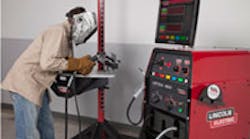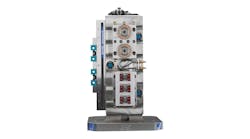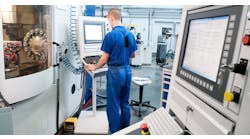[IMTS Preview] Lincoln Electric for Welding Simulator, Environmental Push Pull System, Robotic Technology
Lincoln Electric has developed a new way to teach welding techniques through a virtual welding system called VRTEX 360. The system incorporates technology Lincoln recently acquired from VRSim Inc., an East Harford, Conn.-based leader in the development of training software and graphic simulation for industry and academia. This next-generation virtual welding training system was developed in partnership by teams at Lincoln Electric and VRSim Inc.
Lincoln’s VRTEX 360 is a VRAW (Virtual Reality Arc Welding) training solution and represents the next generation of VR welding training. The VRTEX 360 provides a “virtual” hands-on training experience that allows students to complete more passes than traditional training and provides real-time welding technique feedback similar to a video game to both trainers and students. The VRTEX 360 feeds computer-generated data with a virtual welding gun and helmet equipped with internal monitors. The student practices welding in virtual environments, including simulated welding booth training environment or field welding applications. Training using the VRTEX 360 can be conducted in various settings, including classrooms, an important consideration especially for schools and training centers with limited resources and shop space.
Lincoln Electric Automation has introduced a new robotic arc welding system embedded with advanced technology that redefines available solutions for submerged arc welding (SAW) with a robot.
At the core of this next generation release, Lincoln Electric Automation has patented a wire and flux delivery system that expands the possible applications for robotic submerged arc beyond the normal restrictions of previous mechanized operation. The new, integrated torch design with streamlined flux delivery allows the user to incorporate robotic SAW solutions on corners and path variations, previously not possible with other mechanized gravity fed flux delivery systems.
The system integrates the industry leading Power Wave AC/DC 1000 SD welding power source to ensure superior weld quality results. The machine output is rated 1000 amps, 44 volts at 100 percent duty cycle. With 380-575 VAC, 50/60Hz input voltage capability, the Power Wave AC/DC 1000 SD can be connected anywhere in the world, making equipment deployment easier for global companies.
The digital inverter-based power source features Lincoln Electric's software-driven Waveform Control Technology, resulting in control of DC positive, DC negative, balanced AC and variable AC submerged arc processes without cumbersome mechanical cable swapping. Subtle waveform changes can be made for precise control of the submerged arc deposition rate and penetration. The result over conventional power sources is increased weld speeds, consistently higher quality welds and improved efficiencies in single or multi-arc environment.
The new Power Wave machine features new iArc digital controls, delivering processing speeds up to 90 times faster than the previous generation. The result is faster arc response and greater arc stability.
Lincoln Electric Automation also integrated smart technology into solutions featuring remote weld process monitoring that allows welding operational efficiency analysis using Lincoln Electric's Production Monitoring 2 web-based software.
Lincoln Electric is offering new systems for welding, grinding, gouging and cutting operations provide cleaner, more cost effective and energy conscious environmental solutions.
An alternative concept in shop fume extraction systems, Push Pull systems may be the best recommendation for welding operations impacted by these conditions: Manufacturing and fabrication applications where fume extraction at the source is difficult, fabrication of especially large work pieces, shops that utilize robotic and hard automation welding fixtures and manufacturing where welding work cell locations change.
A Push Pull system captures shop air and welding fume within a given perimeter, filters it, and then pushes the filtered air back into the working air in the same area. This method reduces energy costs, as the heated or cooled air from the shop is circulated back into the manufacturing location rather than exhausted outdoors. Lincoln Electric systems use the methodology of filtering only the immediate work area. The alternative is to filter the full floor to ceiling area, which can dramatically increase costs.
A Push Pull system is a general ventilation solution, which can be used to supplement targeted control of welding fume at the arc. Push Pull systems are intended for use when the goal is to improve general indoor air quality. To comply with upcoming OHSA and EPA regulations, many U.S. plants must conduct performance testing to evaluate worker exposures and plant emissions.






